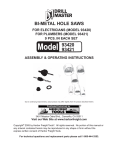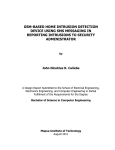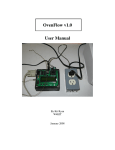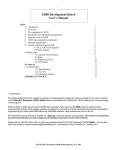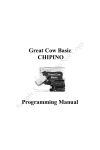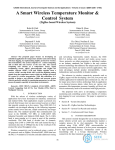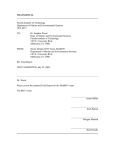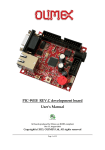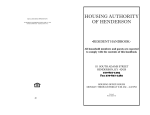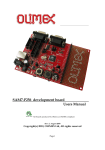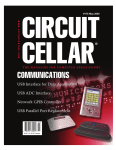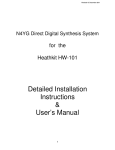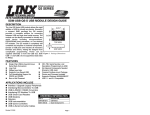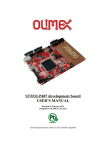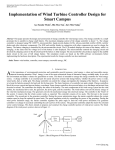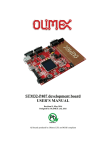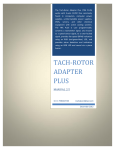Download A Program to Control SMD Soldering Using a Toaster Oven
Transcript
OvenFlow 1.0 A Program to Control SMD Soldering Using a Toaster Oven Ever want to try SMD (surface-mount device) soldering without using a magnifying glass and super steady hands? Production houses use ovens which cost thousands, but it’s possible to do a reasonable job with a regular toaster oven. You just need to control it correctly. Enter the SparkFun Electronics Reflow Toaster Controller. T his controller looked like a great project for experimenting with reflow soldering SMD devices at home, but it came with only rudimentary software. As a learning project, it had many features to explore, including a PIC16F88 MPU, thermocouple temperature sensor using the A/D converter, control buttons for inputs, an LCD readout, and a serial port with boot loader for quick program changes. A personal goal was to get back to low level (near assembly code) programming after decades of being out of touch. Many months and 1,500 lines of C code later, this little controller can really do a lot, including programmed modes and data logging to your PC. Getting Started The controller hardware kit is a snap to build — well SAFETY NOTICES by Kit Ryan packaged components and no SMDs (!). It even includes a power supply. All you need is a serial cable to hook it up to your PC for programming as shown in Figure 1. A feature of this kit is that the PIC16F88 already comes loaded with a boot loader so a real programmer isn’t immediately needed — but more on that later. The kit powers up with the LED flashing and the LCD readout showing “Spark Fun.” Very reassuring that everything works. The circuit, shown in the schematic in Figure 2, is designed to control a relay that can switch 120 VAC for regulating the temperature of an ordinary toaster oven. How it works is that the thermocouple output is amplified and linearized by the Analog Devices AD849 IC to within ±2 degrees F. No adjustment is needed and I found it to be within one degree of the reading compared to room FIGURE 1. Completed controller project. 1) This project involves line voltage connections which are potentially fatal if mishandled. Double-check all wires before applying line voltages. 2) Using the Controller for reflow soldering can result in operating a toaster oven at extremely high temperatures, which can burn fingers or cause fires. 3) Solder materials, whether leadbased or lead-free, can be toxic if ingested. The toaster oven you use for this project should be permanently dedicated to electronics and no longer used for heating food products. PLEASE USE CAUTION WHEN OPERATING THIS CONTROLLER. June 2008 67 OvenFlow 1.0 thermometers. The analog signal is between the range of 0 to +5 volts and fed to one of the PIC port pins to be sampled and converted to a 10-bit digital value. The result is converted into a three-digit display and sent to the LCD readout. Board buttons labelled “Up,” “Down,” and “Select” are sensed by other PIC port pins and are used by the software to control the relay, temperature, and timer functions. One helpful feature of the 16F88 is that you can turn on “weak pull-ups” on its ports. This means the button inputs will read five volts when not pushed and zero volts when pushed without having to put extra “pull-up” resistors to the five volt supply. It’s no wonder the board looks so simple! The power supply regulates the five volts for all the ICs. A MAX232 IC converts the 0 to +5 volt digital signals to and from the PIC to the standard ±12 volt RS-232 levels for interfacing to the PC. Something not supplied with the kit is the AC outlet box seen in the picture. The relay wires are run to this box to switch the hot side of the outlets. An alternative that you may consider safer is to not mount the relay on the Simple is Okay; Complicated is More Fun Toaster ovens can get up to over 500 degrees F — hot enough for SMD soldering. But heat alone is not enough. It takes the right time/temperature profile to melt the solder without destroying the parts or getting solder bridges in the process. A typical SMD heating profile is shown in Figure 3 (courtesy of Kester solder systems). Having a required profile was what drove the need for a “programmed mode.” Since the PIC16F88 can write its own internal EEPROM memory to store a program, all the pieces were there for a really capable circuit! The schematic is reproduced with permission from SparkFun Electronics. The BoostC header file is provided with permission from BoostSource Technologies. (The LG1 Logo U1 Power -IN +IN 1 2 J1 R1 330 LOGO D1 R2 S1 VCC Vin 3 Vout C1 100uF 1N4004 C2 100uF 7805 DC Power D2 Temp R1 1 2 JP1 RAW GND Status_LED circuit board but put it inside the outlet box itself and just run the low voltage control signal back to the controller board. A significant amount of additional information on the hardware, the build kit, and boot loader software is available from the SparkFun website [1]. Status VCC U2 R6 10K VCC U3 +IN 1 2 3 4 5 6 7 IN+ +C +T COM -T -C V- -IN -ALM +ALM V+ COMP VO FB 14 13 12 11 10 9 8 -IN S2 Reset D6 1 D7 2 3 Temp 4 VPP GND 5 6 CS1 7 CS2 RX 8 Status_LED9 RA1/AN1 RA2/AN2/VREFRA3/AN3/VREF+ RA0/AN0 RA4/AN4 RA7/OSC1 RA5/VPP/MCLR RA6/OSC2 VSS VDD RB7/AN6/PGD RB0/INT RB6/AN5/PGC RB1 RB5/TX RB2/RX RB4 RB3 18 17 16 15 14 13 12 11 10 D5 D4 E R/W VCC CS3 RS TX Relay_Control CS1 S3 Up CS2 S4 Down CS3 S5 Select PIC16F88 Temp C9 AD595 VCC 0.1uF C8 VCC RAW LCD1 2x Quick-Connect Solder Lug Connection to Toaster 0.1uF D3 1N4148 Relay_Control R7 10K GND VCC Contrast RS R/W E REL1 SPST-NO Q1 NPN C10 VCC 0.1uF VCC 1N4148 VCC VCC 10uF GND 2 6 C5 Vs+ Vs- RX1IN TX1OUT T1Out T2Out R1In R2In C1+ C1C2+ C2T1In T2In R1Out R2Out 1 3 4 5 C6 10uF R2 10K Contrast C7 10uF 11 TX 10 12 RX 9 15 RS232 10uF TX1OUT 14 7 RX1IN 13 8 VCC MAX232 GND 5 9 4 8 3 7 2 6 1 U4 VCC JC1 GND VCC VEE RS R/W E D0 D1 D2 D3 D4 D5 D6 D7 BL+ BLLCD 16x2 16 C4 D4 1 2 3 4 5 6 7 8 9 10 D4 11 D5 12 D6 13 D7 14 15 GND 16 FIGURE 2. Controller schematic. 68 June 2008 OvenFlow 1.0 author is not affiliated in any way with either company.) FIGURE 3. Standard reflow solder profile. Controller Software The software was developed to be more flexible than just controlling a toaster oven, should you want to apply it to other things. The original SparkFun software — which does have many useful basic code examples in it — has been heavily modified and expanded to get the resulting code described here. The 4K memory limit of the PIC makes life really tough for getting sophisticated with the program. Every “extra” feature or line of code was scrutinized. Heavy use of functions (subroutines) was required to eliminate redundant code. The fact that only 200 useful for calibrating the oven (or making toast). memory locations are left out of 4096 is an indication of how tight it is. The user interface is further hindered 3) Semi-Automatic: The user can set a temperature and having only 2x16 characters on the display and just three the oven will track this temperature and turn the relay control buttons (there is a fourth button for reset only), on and off automatically. This can be used for very long however, a lot can still be done as seen in Figures 4 and 5. operations, such as chemical bath (e.g., etchant) The top line contains the settings for the current temperature control for several hours. mode of operation and the second line shows the functions for the three buttons, marked “up,” “down,” and FIGURE 4. Main Menu LCD screen. “select” on the PC board. Each button can have two functions, depending on Top line – Mode Select: whether a short push or long push “Main Menu” Screen: Manual (greater than two seconds) has been Semi-Auto Program 1 made. The slash mark “/” separates Program 2 short/long functions. Mode: Manual Setup MM x x Nx/Sel A User Manual has been prepared Current mode: which details all the capabilities and MM = Main Menu operating procedures. The modes are described briefly as follows: “up” button function: “down” button function: “select” button function: x = none 1) Main Menu: This comes up first after the splash screen and allows the user to select one of the five operating modes. This is the basic “home” screen and always available when exiting one of the other modes. The only way to exit the Main Menu is to turn off the unit! 2) Manual: Has a stop watch and relay control plus displays the current temperature. The user can manually start/stop/reset the stop watch and turn the relay on or off directly. This mode is “Program” Screen: Nx = next mode (short push) /Sel = select this mode (long push) x = none Timer Program temperature (C or F) Step Number P1 = Program1 P2 = Program2 0 000s 000C 000C P1 R/R Jmp Ed/Ex Actual temperature (C or F) “up” button function: “down” button function: “select” button function: R = run (short) S = stop (short) /R = reset timer (long) Jmp = jump to next step (short or long) Ed = Go to edit mode (short) /Ex = exit back to Main Menu (long) FIGURE 5. Program Mode LCD screen. June 2008 69 OvenFlow 1.0 4) Program 1 and 2: This is the most capable mode of the software, permitting the controller to follow a time/ temperature profile with up to 10 steps. Each step is programmable by the user and both the setting and the actual temperatures are displayed in real time. The software comes with a built-in profile similar to the Kester solder curve to make getting started easier. It can, of course, be modified. A nice feature of the programmer is that the steps for up to two programs are retained in the EEPROM on the onboard PIC16F88 after the unit is turned off. The LCD display for this mode shows how much information can be crammed into just 32 characters. 5) Setup: Five variables can be modified to tailor the controller to user preferences, including: • Temperature units (Celsius or Fahrenheit). • Time/temperature increment (during programming, the amount of change for each button push can be varied between one and 10 seconds or degrees). • LED on with relay (gives a visual indication that the relay has been switched on; kind-of a safety feature). • Clock calibration (allows a ± 2% change to the built-in system clock to get the one second timer as accurate as desired). • Time constant (helps the control system compensate for the lag time in heating up the oven elements). In addition, the controller program has a data logger function which will output the time, set temperature, actual temperature, and relay on/off conditions to your PC. Data points are sent once per second. It uses the built-in serial port on the board (a nice to have feature!) and is directly readable by HyperTerminal or similar programs. The data can be easily copied into Excel and analyzed or plotted, as seen in some of the plots in this article. Software Tools Selection Every programmer has to select tools and it’s never an 300 250 200 150 100 50 easy choice. Cost, complexity (including the learning curve), and capability are all factors. In selecting BoostC over CC5X — which seems to be the standard compiler in most articles — the cost differential of many $100s was important. As this was my first PIC programming effort, and not knowing whether I would like it or be successful or ever want to do it again, I opted for a very low cost entry into the process. It turns out that this compiler behaves very well, the cost is incredibly low, and there is excellent user support through the forums. I could often get a response to a question back in 24 hours from the creator of the compiler. I didn’t come across a single bug either, although a few features could be improved, such as error messages. It also integrates right into the Microchip MPLAB IDE, too, for a consistent programming environment. For those of you who want to tweak the code with another compiler, there are several things which must be changed globally, including: using small letters for all the register names; changing the way binary numbers are entered; and, of course, pragma usage. The boot loader from SparkFun proved to be more problematic. It worked perfectly over the serial port during the early days of program development, when I was making tons of stupid mistakes during the learning process. However, when the program size became larger than 2K (which is half of what the PIC16F88 can accommodate), the process went “tilt.” There are some peculiarities in the way the PIC programs jump to addresses above 2K that are incompatible with the SparkFun boot loading scheme. Luckily, by that point, my programming skills had improved and I could use my ICD2 clone to directly burn-in the program changes to the PIC. It was not as onerous as I had originally thought, taking only about 30 seconds for a complete remove/burn/re-install cycle. Cooking Right Along To start, I suggest trying out the oven in Manual Mode; just switching the relay on and leaving it there for perhaps four minutes. Use HyperTerminal to collect the serial data output and plot the heating characteristic. First try, I ran into a problem before the temperature had peaked — the oven’s thermal cutout safety switch clicked out at 220°C, just enough for regular solder to melt but not for lead-free RoHS work. I found that by adjusting the little metal tab on the temperature dial inside the oven cabinet, I could raise the limit to 250°C, which is enough. Of course, unplug the oven before taking screwdriver in hand! The second attempt then 0 0 70 50 June 2008 100 150 200 250 FIGURE 6. Toaster oven heating curve — Manual Mode. OvenFlow 1.0 looked like Figure 6. Notice there 250 is a time lag while the elements heat up, then the slope increases nicely. The slope of the curve at 200 any point is the “degrees per second” that the oven can heat. 150 This is important since the slope of the desired curve needs to be able to match the soldering 100 curve requirements. If you need more heating rate than the oven can produce, you’re out of luck 50 — and need to get a more powerful oven. My oven is a few 0 years old, luckily, and has 1,550 0 50 watts, so it can get up to about two degrees C/sec. Many newer ovens come with only 1,200 watts and may have commensurately lower heating rates, although their insulation may be better. My suggestion is to go to yard sales and/or Craig’s list and look for one with a high power rating. The toughest part of the curve to meet is at the top, when the oven is already quite hot but where it still has to climb quickly from about 180 degrees to 215 (leadbased solder) or 235 (RoHS) degrees in just 30 seconds, but the heating capability is at its lowest (least slope). Following the initial test, I then tried out the Program Mode using the built-in settings that approximate the Kester curve in five steps. If you allow for the warm-up period, which takes about 20 seconds, the tracking is quite good (see Figure 7; pink curve vs. blue curve). The plot actually shows the result of much “tuning” of the relay control algorithm compared to my original simplistic “turn on relay if the temp is below the program; turn off relay if it’s above” approach. The final algorithm looks ahead about six seconds to where the temperature needs to be — called the “set_temp” — and compares it to where the actual temperature appears to be headed: the “projected_temp.” The weighting of the two values, the current temperature error, and the projected temperature error, can be adjusted to allow good tracking with different ovens. OvenFlow allows for a time constant variable which the user can adjust to help with the projected temperature function. The initial warm-up time lag is best adjusted by inserting a first program step of around 15-25 seconds at room temperature before trying to track the soldering curve. One interesting aspect of control loops (such as the one in the program) is their tendency to oscillate around the desired set point. Oscillations are clearly visible in the pink curve. However, since it’s only a few degrees off at any point, it appears adequate for the SMD soldering function of interest. Another thing to be noted is the cool-off period at the end of the heating cycle, starting at about 230 seconds. Toaster ovens appear to have enough insulation — usually through a double skin of the oven itself — that they don’t cool off very fast. According to the FIGURE 7. Program Mode temperature tracking. Program Temp Actual Temp 100 150 200 250 300 experts, the cool-down rate is important to get solder joints that are not too brittle. One way that can work here is to open the oven door in a controlled manner while watching the actual temperature fall. Yes, But Does It Work? The moment of truth had come. I took an old PC memory stick which has many surface-mount chips on it with close leads (0.68 mm spacing), and removed one of them using a heated air de-soldering tool. The back of the board had new, unused pads on it to which I applied liquid flux from a pen. Then I smeared on a thin layer of real solder paste evenly across the pads to be representative of what could be done at home without a custom cut solder paste stencil, put one of the chips back in position on the pads, and ran the controller program in the oven. The photo in Figure 8 shows an excellent solder joint with no bridges at all. The solder paste didn’t stick to the masked and fluxed areas between the pins. I probably could have applied a little more solder paste. This is not to say the process is foolproof yet, but it looks like it can be made FIGURE 8. Close-up of actual SMD soldering. June 2008 71 OvenFlow 1.0 to work with a little effort. Do It Yourself The hardware is obtainable from SparkFun Electronics and saves a lot of time compared to assembling your own circuit from scratch. If you do go it alone, just be sure to follow the schematic exactly and absolutely use a PIC16F88 MPU because every PIC is slightly different and the software will likely not work with another MPU. Add the outlet box and then download the software from the Spark Fun site. I’ve included two versions of the program there for your enjoyment: a .hex file that can be burned directly into the MPU using a programmer, and a C file and associated header files in case you want to play around with the program yourself. Do a search for “reflow” to find the controller info and files. Sorry, but there’s no easy way around using a programmer unless someone comes up with a tiny bootloader that’s compatible with the large program size. This particular MPU is actually designed for in-circuit programming but that feature is not built into the SparkFun kit and will probably require some circuit modifications to make it work. Even so, a programmer would still be required. Also posted on the SparkFun website is a complete User Manual for the program that explains all the screens and control functions. That manual includes a more in-depth discussion of the software, too. Be aware that the PIC16F88 has only 4K of program memory and the program described in this article uses 95% of it! If you want to add more features, you’ll likely have to cut something out. NV REFERENCES [1] SparkFun Electronics controller & software (ssparkfun.com) [2] Kester SMD soldering time/temp profile (kkester.com) [3] BoostC C compiler (ssource boost.com) 72 June 2008






